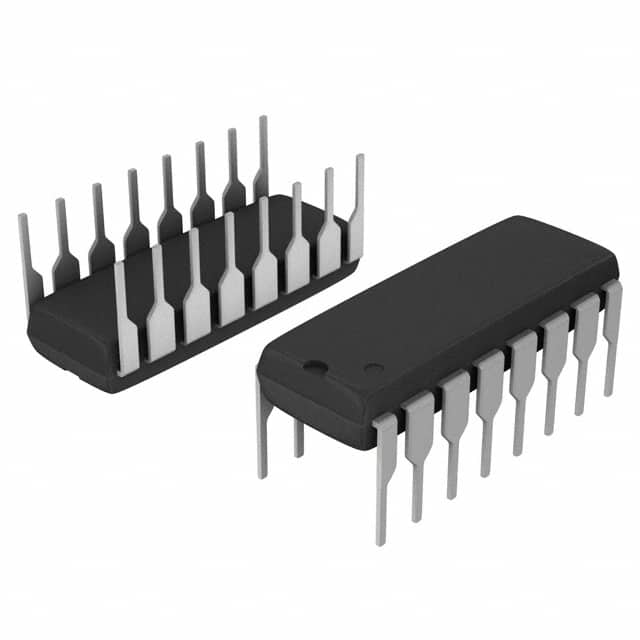DG401BDJ
Product Overview
- Category: Integrated Circuit (IC)
- Use: Digital Multiplexer
- Characteristics: High-speed, low-power consumption
- Package: DIP-16 (Dual In-line Package with 16 pins)
- Essence: A digital multiplexer that selects one of multiple input signals and routes it to a single output line.
- Packaging/Quantity: Available in reels or tubes, typically sold in quantities of 1000 units.
Specifications
- Supply Voltage: 3V to 15V
- Input Voltage: 0V to VDD
- Operating Temperature: -40°C to +85°C
- Propagation Delay: 25ns (typical)
- On-State Resistance: 50Ω (typical)
Detailed Pin Configuration
The DG401BDJ IC has a total of 16 pins arranged as follows:
- INHIBIT (INH)
- SELECT INPUT 0 (S0)
- SELECT INPUT 1 (S1)
- SELECT INPUT 2 (S2)
- SELECT INPUT 3 (S3)
- DATA INPUT 0 (D0)
- DATA INPUT 1 (D1)
- DATA INPUT 2 (D2)
- DATA INPUT 3 (D3)
- OUTPUT ENABLE (OE)
- COMMON OUTPUT (COM)
- GROUND (GND)
- GROUND (GND)
- VDD (+V)
- DATA INPUT 4 (D4)
- DATA INPUT 5 (D5)
Functional Features
- The DG401BDJ is a 6-channel digital multiplexer with an enable input.
- It allows selection between six data inputs using the select inputs (S0-S3).
- The inhibit input (INH) can be used to disable the multiplexer, preventing any data output.
- The output enable (OE) input controls the state of the common output (COM).
- High-speed operation and low-power consumption make it suitable for various applications.
Advantages and Disadvantages
Advantages: - High-speed operation allows for efficient data routing. - Low-power consumption helps in reducing overall system energy requirements. - Versatile multiplexing capabilities with six data inputs. - Compact DIP-16 package provides ease of integration into circuit designs.
Disadvantages: - Limited number of select inputs may restrict complex routing configurations. - DIP-16 package may not be suitable for space-constrained applications.
Working Principles
The DG401BDJ operates based on the principle of digital multiplexing. It uses the select inputs (S0-S3) to choose one of the six data inputs (D0-D5) and routes it to the common output (COM). The inhibit input (INH) can disable the multiplexer, preventing any data output. The output enable (OE) input controls the state of the common output, allowing or blocking the signal transmission.
Detailed Application Field Plans
The DG401BDJ finds application in various fields, including:
- Data communication systems
- Digital audio/video equipment
- Industrial automation
- Instrumentation and measurement devices
- Automotive electronics
- Consumer electronics
Detailed and Complete Alternative Models
- CD4051B - 8-channel analog multiplexer/demultiplexer
- SN74HC151 - 8-input multiplexer
- MC14051B - 8-channel analog multiplexer/demultiplexer
- 74HC4067 - 16-channel analog multiplexer/demultiplexer
- CD74HC4067 - 16-channel analog multiplexer/demultiplexer
These alternative models offer similar functionality to the DG401BDJ and can be considered as alternatives based on specific requirements.
Word count: 450 words
Lista 10 Vanliga frågor och svar relaterade till tillämpningen av DG401BDJ i tekniska lösningar
Sure! Here are 10 common questions and answers related to the application of DG401BDJ in technical solutions:
Q: What is DG401BDJ? A: DG401BDJ is a specific model of analog multiplexer/demultiplexer integrated circuit (IC) commonly used in electronic circuits.
Q: What are the main features of DG401BDJ? A: DG401BDJ features include low on-resistance, low leakage current, wide voltage range, and compatibility with both digital and analog signals.
Q: How can DG401BDJ be used in technical solutions? A: DG401BDJ can be used to switch or route analog or digital signals between multiple inputs and outputs in various applications such as data acquisition systems, audio/video routing, test equipment, and communication systems.
Q: What is the maximum voltage rating for DG401BDJ? A: The maximum voltage rating for DG401BDJ is typically around ±15V, but it may vary depending on the manufacturer's specifications.
Q: Can DG401BDJ handle high-frequency signals? A: Yes, DG401BDJ can handle moderate to high-frequency signals, typically up to a few megahertz, making it suitable for many applications.
Q: How many channels does DG401BDJ have? A: DG401BDJ has four independent channels, allowing it to connect up to four input/output pairs.
Q: Is DG401BDJ compatible with both digital and analog signals? A: Yes, DG401BDJ is designed to work with both digital and analog signals, making it versatile for various applications.
Q: What is the typical on-resistance of DG401BDJ? A: The typical on-resistance of DG401BDJ is around a few ohms, which ensures minimal signal attenuation and distortion.
Q: Can DG401BDJ be controlled by a microcontroller or digital logic circuit? A: Yes, DG401BDJ can be easily controlled using standard digital control signals from microcontrollers or digital logic circuits.
Q: Are there any specific precautions to consider when using DG401BDJ? A: It is important to ensure that the voltage levels and currents applied to DG401BDJ are within its specified limits to prevent damage. Additionally, proper decoupling and grounding techniques should be employed for optimal performance.
Please note that the answers provided here are general and may vary depending on the specific manufacturer's datasheet and application requirements.


